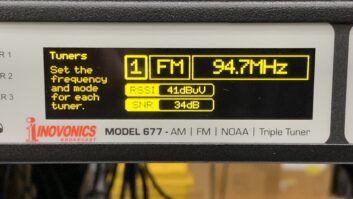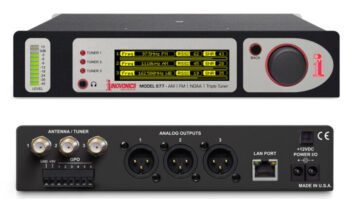ROCKFORD, Ill. — As part of a recent transmitter upgrade, Maverick Media of Rockford decided to add RDS capability to two of our stations, WXRX(FM) and its HD2 (AM station WNTA). Though far from a new standard, the technology finally seems to be gaining some maturity and RBDS-capable receivers have gained some respectable market penetration, so the time seemed right for us to break into datacasting.
Using the maxim “if it’s worth doing, it’s worth doing well,” we opted for Inovonics 730 RDS encoders, which appeared to offer the best package of capabilities available on the market.

IP connectivity
Though I have no history with comparable products, my hands-on experience with these units seems to bear out our initial impression.
One useful feature of these units is that they do not rely exclusively on serial input to receive data. They will connect to a network and can be addressed by IP. This has turned out to be crucial for our installation, as the point-to-point IP connection to our transmitter site works quite well but the method we’d planned to use to establish serial communications over that link was not successful.
Each 730 unit can use three ports simultaneously, two for TCP connections and one for UDP connectionless communication, so I can use the included software to retrieve and/or change settings on either unit without interfering with its regular updates by other software, or multiple servers can send independent updates without conflict.
It’s difficult to evaluate these units independently of the software that updates them, however. While the included program is excellent for modifying settings and setting static messages (including a default message to use if the data feed is interrupted) via USB or IP, it would be impossible to keep up with “now playing” information or spot-triggered sponsorship messages.
These units included a trial version of Center Stage software from Arctic Palm, which was able to do this, as well as set RadioText Plus tags for the artist and album fields, and to download, parse and send regular weather updates to one of the encoders.
We selected Broadcast Electronics’ The Radio Experience program instead, favoring its user interface. It also allows management of scheduled and triggered messages through a website, whereas CS required users to install a program and connect directly to our network.
Ultimately, though, neither of these programs seems capable of using the full features of the 730 encoder; e.g. neither can set RT+ tags like program host and station name for our talk station, though it’s possible to do so by sending the appropriate command to the unit. The 730s are the most capable devices in our datacasting chain, with features waiting unused for now.
As another example, our EAS units are able to send alert messages that supersede regular messages, but required an update to do so, which was not available when we installed them a few months ago. That confidence in the devices’ future capabilities has made them well worth the investment, especially since Inovonics’ technical support has been eager to assist with every new application we have attempted.
Jerry Mitchell works in engineering/IT for Maverick Media of Rockford.
For information, contact Lukas Hurwitz at Inovonics in California at (831) 458-0552 or visit www.inovonicsbroadcast.com.












